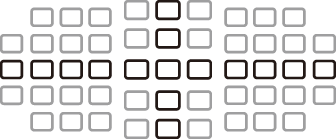Compatible Flash Units
The Nikon Creative Lighting System (CLS)
Nikon’s advanced Creative Lighting System (CLS) supports a variety of features thanks to improved communication between the camera and compatible flash units.
Features Available with CLS-Compatible Flash Units
|
Supported features |
Flash unit |
|||||||||||
|---|---|---|---|---|---|---|---|---|---|---|---|---|
|
SB‑5000 |
SB‑910/ |
SB‑700 |
SB‑600 |
SB‑500 |
SU‑800 |
SB‑R200 |
SB‑400 |
SB‑300 |
||||
|
Single flash |
i‑TTL |
i‑TTL balanced fill-flash for digital SLR 1 |
4 |
4 |
4 |
4 |
4 |
— |
— |
4 |
4 |
|
|
Standard i‑TTL fill-flash for digital SLR |
4 2 |
4 2 |
4 |
4 2 |
4 |
— |
— |
4 |
4 |
|||
|
qA |
Auto aperture |
4 |
4 3 |
— |
— |
— |
— |
— |
— |
— |
||
|
A |
Non-TTL auto |
— |
4 3 |
— |
— |
— |
— |
— |
— |
— |
||
|
GN |
Distance-priority manual |
4 |
4 |
4 |
— |
— |
— |
— |
— |
— |
||
|
M |
Manual |
4 |
4 |
4 |
4 |
4 4 |
— |
— |
4 4 |
4 4 |
||
|
RPT |
Repeating flash |
4 |
4 |
— |
— |
— |
— |
— |
— |
— |
||
|
Optical Advanced Wireless Lighting |
Master |
Remote flash control |
4 |
4 |
4 |
— |
4 4 |
4 |
— |
— |
— |
|
|
i‑TTL |
i‑TTL |
4 |
4 |
4 |
— |
4 4 |
— |
— |
— |
— |
||
|
[] |
Quick wireless flash control |
4 |
— |
4 |
— |
— |
4 5 |
— |
— |
— |
||
|
qA |
Auto aperture |
4 |
4 |
— |
— |
— |
— |
— |
— |
— |
||
|
A |
Non-TTL auto |
— |
— |
— |
— |
— |
— |
— |
— |
— |
||
|
M |
Manual |
4 |
4 |
4 |
— |
4 4 |
— |
— |
— |
— |
||
|
RPT |
Repeating flash |
4 |
4 |
— |
— |
— |
— |
— |
— |
— |
||
|
Remote |
i‑TTL |
i‑TTL |
4 |
4 |
4 |
4 |
4 |
— |
4 |
— |
— |
|
|
[] |
Quick wireless flash control |
4 |
4 |
4 |
4 |
4 |
— |
4 |
— |
— |
||
|
qA/A |
Auto aperture/non-TTL auto |
4 6 |
4 6 |
— |
— |
— |
— |
— |
— |
— |
||
|
M |
Manual |
4 |
4 |
4 |
4 |
4 |
— |
4 |
— |
— |
||
|
RPT |
Repeating flash |
4 |
4 |
4 |
4 |
4 |
— |
— |
— |
— |
||
|
Radio-controlled Advanced Wireless Lighting |
4 7 |
— |
— |
— |
— |
— |
— |
— |
— |
|||
|
Color Information Communication (flash) |
4 |
4 |
4 |
4 |
4 |
— |
— |
4 |
4 |
|||
|
Color Information Communication (LED light) |
— |
— |
— |
— |
4 |
— |
— |
— |
— |
|||
|
Auto FP high-speed sync 8 |
4 |
4 |
4 |
4 |
4 |
4 |
4 |
— |
— |
|||
|
FV lock 9 |
4 |
4 |
4 |
4 |
4 |
4 |
4 |
4 |
4 |
|||
|
Red-eye reduction |
4 |
4 |
4 |
4 |
4 |
— |
— |
4 |
— |
|||
|
Camera modeling illumination |
4 |
4 |
4 |
4 |
4 |
4 |
4 |
— |
— |
|||
|
Unified flash control |
4 |
— |
— |
— |
4 |
— |
— |
4 |
4 |
|||
|
Camera flash unit firmware update |
4 |
4 10 |
4 |
— |
4 |
— |
— |
— |
4 |
|||
-
Not available with spot metering.
-
Can also be selected via the flash unit.
-
qA/A mode selection is performed on the flash unit using custom settings.
-
Can be selected using the [] item in the camera menus.
-
Available during close-up photography only.
-
Choice of qA and A depends on the option selected with the master flash.
-
Supports the same features as remote flash units with optical AWL.
-
Available only in i‑TTL, qA, A, GN, and M flash-control modes.
-
Available only in i‑TTL flash control mode or when the flash is configured to emit monitor preflashes in qA or A flash control mode.
-
Firmware updates for the SB‑910 and SB‑900 can be performed from the camera.
The SU‑800 Wireless Speedlight Commander
When mounted on a CLS-compatible camera, the SU‑800 can be used as a commander for SB‑5000, SB‑910, SB‑900, SB‑800, SB‑700, SB‑600, SB‑500, or SB‑R200 flash units. Group flash control is supported for up to three groups. The SU‑800 itself is not equipped with a flash.
The following flash units can be used in non-TTL auto (A) and manual modes. The options available do not vary with the lens used.
|
Supported features |
Flash unit |
|||||
|---|---|---|---|---|---|---|
|
SB‑80DX |
SB‑50DX |
SB‑28 |
SB‑30 |
SB‑23 |
||
|
A |
Non-TTL auto |
4 |
— |
4 |
4 |
— |
|
M |
Manual |
4 |
4 |
4 |
4 |
4 |
|
G |
Repeating flash |
4 |
— |
4 |
— |
— |
|
REAR 2 |
Rear-curtain sync |
4 |
4 |
4 |
4 |
4 |
-
Mounting an SB‑27 on the camera automatically sets the flash mode to TTL, but setting the flash mode to TTL disables the shutter release. Set the SB‑27 to A.
-
Available when the camera is used to select the flash mode.
The areas metered when FV lock is used with optional flash units are as follows:
|
Picture taken with |
Flash control mode |
Metered area |
|---|---|---|
|
Stand-alone flash unit |
i‑TTL |
6-mm circle in center of frame |
|
Auto aperture (qA) |
Area metered by flash exposure meter |
|
|
Remote flash units controlled via Advanced Wireless Lighting |
i‑TTL |
Entire frame |
|
Auto aperture (qA) |
Area metered by flash exposure meter |
|
|
Non-TTL auto (A) |
-
Refer to the flash unit manual for detailed instructions.
-
If the unit supports CLS, refer to the section on CLS-compatible digital SLR cameras. This camera is not included in the “digital SLR” category in the SB‑80DX, SB‑28DX, and SB‑50DX manuals.
-
If the flash-ready indicator (c) flashes for about three seconds after a photograph is taken in i‑TTL or non-TTL auto mode, the flash has fired at full power and the photograph may be underexposed (CLS-compatible flash units only).
-
i‑TTL flash control can be used at ISO sensitivities between 100 and 12800.
-
At ISO sensitivities over 12800, the desired results may not be achieved at some ranges or aperture settings.
-
In mode P, the maximum aperture (minimum f-number) is limited according to ISO sensitivity, as shown below:
Maximum aperture (f-number) at ISO equivalent of:
100
200
400
800
1600
3200
6400
12800
4
5
5.6
7.1
8
10
11
13
-
If the maximum aperture of the lens is smaller than given above, the maximum value for aperture will be the maximum aperture of the lens.
-
-
The SB‑5000, SB‑910, SB‑900, SB‑800, SB‑700, SB‑600, SB‑500, and SB‑400 provide red-eye reduction in red-eye reduction and slow-sync with red-eye reduction flash modes.
-
“Noise” in the form of lines may appear in flash photographs taken with an SD-9 or SD-8A high-performance battery pack attached directly to the camera. Reduce ISO sensitivity or increase the distance between the camera and the battery pack.
-
During viewfinder photography, the SB-5000, SB-910, SB-900, SB-800, SB-700, SB-600, and SU-800 provide AF-assist illumination as required.
-
The SB‑5000 supports AF‑assist illumination with 24–135 mm AF lenses. During viewfinder photography, AF-assist is available with the focus points highlighted in the illustration.
Focus points for which AF‑assist illumination is available
Focal length 24–30 mm
Focal length 31–48 mm
Focal length 49–135 mm



-
The SB‑910 and SB‑900 support AF‑assist illumination with 17–135 mm AF lenses. During viewfinder photography, AF-assist illumination is available with the focus points highlighted in the illustration.
Focus points for which AF‑assist illumination is available

-
The SB‑800, SB‑600, and SU‑800 support AF‑assist illumination with 24–105 mm AF lenses. During viewfinder photography, AF-assist illumination is available with the focus points highlighted in the illustration.
Focus points for which AF‑assist illumination is available
Focal length 24–31 mm
Focal length 32–105 mm


-
The SB‑700 supports AF‑assist illumination with 24–135 mm AF lenses. During viewfinder photography, AF-assist illumination is available with the focus points highlighted in the illustration.
Focus points for which AF‑assist illumination is available

-
Depending on the lens used and scene recorded, the in-focus indicator (I) may be displayed when the subject is not in focus, or the camera may be unable to focus and the shutter release will be disabled.
-
When an SC-series 17, 28, or 29 sync cable is used for off-camera flash photography, correct exposure may not be achieved in i‑TTL mode. We recommend that you select standard i‑TTL fill-flash. Take a test shot and view the results in the monitor.
-
In i‑TTL, do not use any form of flash panel (diffusion panel) other than the flash unit’s built-in flash panel or bounce adapters provided with the flash unit. Using other panels may produce incorrect exposure.
In i‑TTL and auto aperture (qA) flash control modes, the flash compensation selected with the optional flash unit or the [] item in the photo shooting menu is added to the flash compensation selected with the c (Y) button.
-
Optional CLS-compatible flash units emit a modeling flash when the camera Pv button is pressed.
-
This feature can be used with Advanced Wireless Lighting to preview the total lighting effect achieved with multiple flash units.
-
Modeling illumination can be turned off by selecting [] for Custom Setting e5 [].
